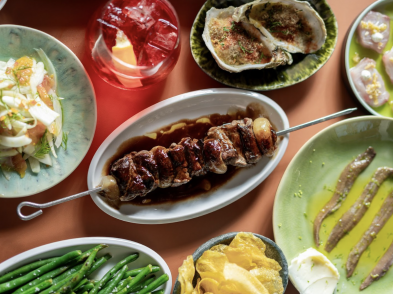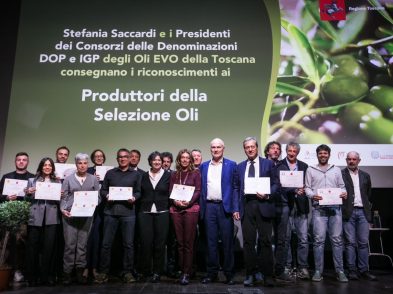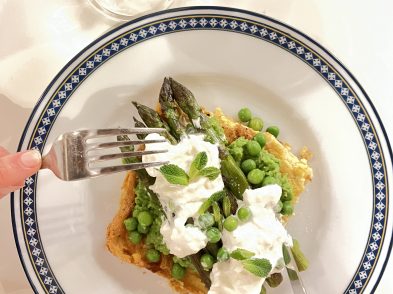A sought-after destination for the likes of Queen Victoria, the St. Regis Florence is now more than just a luxurious place to stay. The Art Deco-style winter garden at one of Florence’s leading hotels has opened its doors to Valeria Piccini, one of Tuscany’s few two-starred Michelin chefs, and her cuisine from Montemerano, in the Maremma. TF had a chat with Piccini about her origins and influences.
Helen Farrell: Your restaurant, Caino, is located in the heart of the Maremma, in southern Tuscany. How did the collaboration with St. Regis come about?
Valeria Piccini:Well, we were looking for a sort of ‘showcase’ in Florence, and St. Regis was looking for a chef to give a Tuscan feel to its cuisine. Effectively, on the days when Caino is closed, I commute to Florence from Montemerano.


HF: That’s quite a commute: 3.5 hours by car.
VP: Yes, it’s tiring but it’s a pleasure as I get to work with some great people in the kitchen here and in Montemerano.
HF: Caino is a family-run restaurant. Did you inherit your passion for food and cooking?
VP: Yes, although the restaurant originally belonged to my husband’s family—they opened it in the 1970s. My love of cooking goes a long way back, though the focus of my high school studies was in chemistry.
HF: Does the chemistry aspect have an impact on your cooking at all?
VP: It helps in giving it a sort of millimetric precision. For instance, there are times when it is important to use five drops of balsamic vinegar instead of seven. All of these tiny details make a difference.
HF: Can you tell us a bit about your origins and how your cuisine reflects them?
VP: I was born in the Maremma, but my family comes from the Casentino area, north of Florence. They moved to the Maremma due to transhumance, when livestock was moved in the winter from Casentino down to the south in search of pastures. Because of this, I am strongly drawn to sheep and dairy products.
HF: So, I imagine that your famous pane con la ricotta (ricotta bread) stems from this love.
VP:It does indeed. In the past, all cheese was made at home. Every day we had fresh ricotta, so it found its way into many dishes, like gnudi for example, whereby flour is mixed into ricotta at the last minute. Then there’s pasta with ricotta, bread with ricotta, desserts made from ricotta.

HF: Other than your love for dairy products, what other farming influences does your cuisine display?
VP: The need to use every part of an animal. We would eat a sheep from head to tail. Even the tail would be skinned and eaten. We wouldn’t throw anything away: we’d eat the offal and the brain. Sadly, today, there’s this aversion towards eating every part of an animal.
HF: Caino has two Michelin stars. What does the recognition mean to you?
VP: It’s a huge recognition and gratification for a chef who has made it on her own. I didn’t go to catering school so I had no foundation for ever aspiring to achieve this. It goes to show that with a desire to succeed, you can do just that.
HF :Do you remember that moment when you find out about the first star?
VP: Oh yes! I didn’t expect it at all. I’d heard rumours that the Maremma was going to get a star, but I never thought it was going to be us. And about the second star, a colleague called me the night before, saying he’d seen our second star in a Michelin guide that had been published before the news had been announced—I don’t know what had happened. I got off the phone, grinning, and my husband and the restaurant staff thought I was mad!
HF: Is there a dish that you serve here at St. Regis that you feel best represents Valeria Piccini?
VP: In the winter, there’s my tortelli filled with Cinta senese pork. In the spring, my pappardelle accoppiate, which are two sheets of pasta with cheese in the middle. People who have eaten at Caino will recognise my cooking style in both of these dishes; they are both very ‘me.’

RECIPE
Valeria Piccini’s paired pappardelle with pit-matured cheese, asparagus and pancetta
Ingredients
For the yellow pasta:
15 eggs
400g semolina
1,100g white flour, preferably “00”
For the green pasta:
500g spinach, blanched, cooled and pureed with 10 eggs
300g semolina
900g white flour, preferably “00”
Salt and pepper to taste
Formaggio di fossa (or pit-matured cheese)
To serve
40g pancetta strips
50g spring onions, cut into strips
200g asparagus, sliced
Broth
Method
Mix the two pasta doughs separately and set aside to rest for about 1 hour. Use a pasta machine to make two separate sheets of pasta, one yellow, one green, measuring the same length and thickness. Dampen one of the two sheets with a little water and sprinkle with the cheese. Place one sheet on top of the other, pairing them together. Cut into pappardelle.
Cook the pasta in plenty of salted, boiling water with a drizzle of olive oil.
Brown the pancetta in a pan over low heat. Remove from the pan and set aside. Sauté the onions and add the thicker parts of the asparagus.
Drain the pasta and toss with the pancetta and a little broth. Keeping the pan close to the heat and at 70°C, add the cheese and a drizzle of extra-virgin olive oil. Garnish with asparagus tips and crispy pancetta.
Tip
If the pit-matured cheese proves too strong a flavour, mix with a little parmesan.







